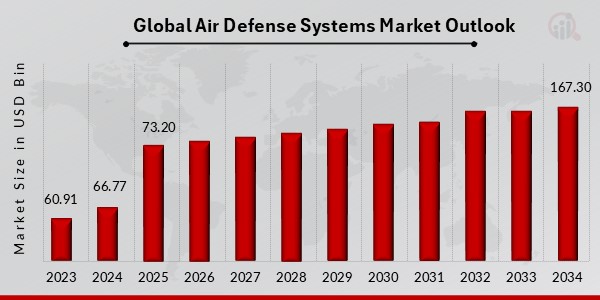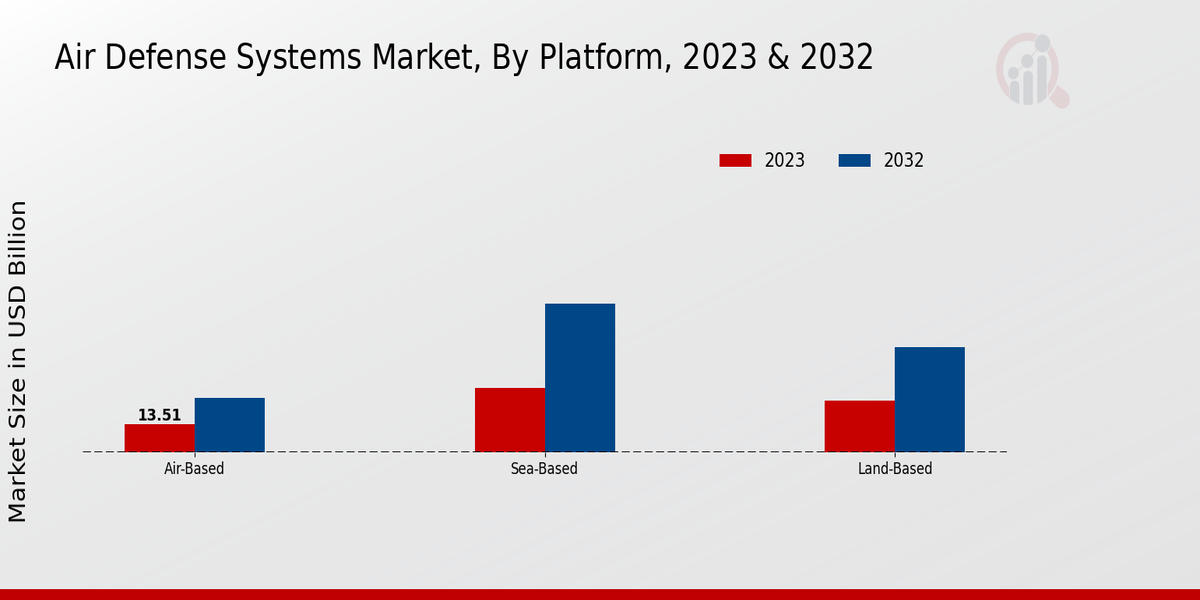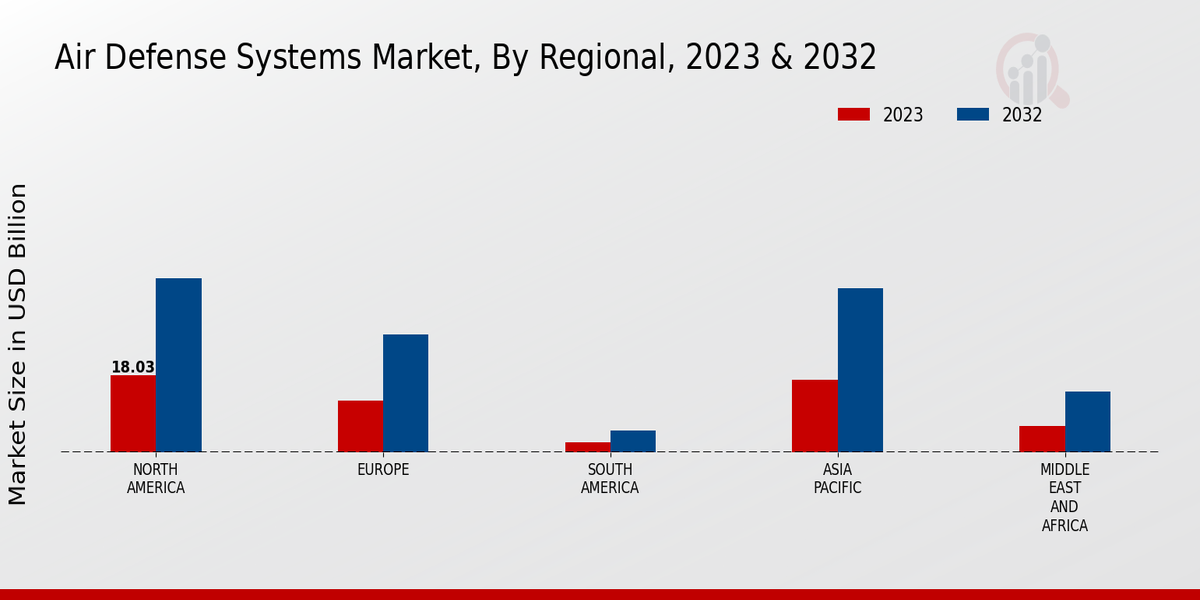Air Defense Systems Market Overview
Air Defense Systems Market Size was estimated at 66.77 (USD Billion) in 2024.The Air Defense Systems Market Industry is expected to grow from 73.20 (USD Billion) in 2025 to 167.30 (USD Billion) by 2034. The Air Defense Systems Market CAGR (growth rate) is expected to be around 9.6% during the forecast period (2025 - 2034).

Source Primary Research, Secondary Research, MRFR Database and Analyst Review
Key Air Defense Systems Market Trends Highlighted
The air defense systems market is poised for significant growth, driven by rising geopolitical tensions and the increasing sophistication of modern air threats. Advancements in technology, such as artificial intelligence and hypersonic weapons, are also contributing to the market's expansion. Key drivers include the need for protection against hostile aircraft, cruise missiles, and unmanned aerial vehicles.
Recent trends have highlighted the importance of multi-layered air defense systems that can detect, track, and intercept a wide range of threats. The integration of advanced sensors, radar systems, and interceptors enables comprehensive protection. Moreover, interoperability between air defense systems is becoming increasingly crucial for effective joint operations.
Opportunities for growth in the air defense systems market lie in exploring advanced technologies such as directed energy weapons and hypersonic interceptors. The development of these systems has the potential to revolutionize air defense capabilities. Additionally, the growing demand for mobile and transportable air defense systems offers significant potential for market expansion.
Air Defense Systems Market Drivers
Increased Demand for Air Defense Systems due to Geopolitical Tensions and Conflicts
Escalating geopolitical tensions, regional conflicts, and the threat of terrorism have heightened the need for robust air defense systems globally. Governments worldwide are investing heavily in upgrading and expanding their air defense capabilities to protect critical infrastructure, military assets, and civilian populations from aerial threats. The ongoing conflicts in regions such as the Middle East, Eastern Europe, and Asia-Pacific have demonstrated the importance of effective air defense systems in deterring and countering aerial attacks.The growing risk of drone warfare and the proliferation of unmanned aerial vehicles (UAVs) have further emphasized the need for advanced air defense systems capable of detecting, tracking, and neutralizing these emerging threats.
Advancements in Technology Driving Innovation in Air Defense Systems
The Air Defense Systems Market Industry is witnessing areas of high innovation with rapid technology advancements, particularly in radar systems, electronic warfare, and missile defense technologies. Air defense systems are being integrated with advanced sensors and artificial intelligence and machine learning algorithms are used to effectively detect and track targets for engaging the same. These systems integrated with new technologies are expected to increase the precision and efficiency in target detection and engagement.Additionally, the development of directed energy weapons and hypersonic missiles is paving opportunities for better air defense systems development.
Growing Focus on Homeland Security and Critical Infrastructure Protection
Heightened concerns over homeland security and the protection of critical infrastructure have spurred demand for air defense systems. Governments and organizations recognize the importance of safeguarding strategic assets, such as airports, energy facilities, and government buildings, from potential aerial threats. The increasing frequency of terrorist attacks and the rise of asymmetric warfare have prompted governments to invest in advanced air defense systems to enhance their ability to detect, intercept, and neutralize malicious aircraft and missiles.The growing threat of cyberattacks on critical infrastructure further underscores the need for robust air defense systems capable of protecting against both physical and cyber threats.
Air Defense Systems Market Segment Insights
Air Defense Systems Market Platform Insights
The Air Defense Systems Market revenue is expected to grow significantly over the next ten years. The market is segmented by platform, and the three main segments are land-based, sea-based, and air-based. Land-based systems are the most common type of air defense system, and they are typically used to protect military bases, airports, and other critical infrastructure. Sea-based systems are used to protect naval vessels, while air-based systems are used to protect aircraft. The land-based segment is expected to account for the largest share of the Air Defense Systems Market revenue in 2024.This is due to the increasing demand for land-based systems to protect critical infrastructure and military bases from aerial threats. The sea-based segment is expected to grow at a faster rate than the land-based segment, due to the increasing demand for sea-based systems to protect naval vessels from aerial threats. The air-based segment is expected to grow at a slower rate than the other two segments, due to the decreasing demand for air-based systems to protect aircraft from aerial threats. Overall, the Air Defense Systems Market is expected to grow at a healthy rate over the next ten years.The growth of the market is being driven by the increasing demand for air defense systems to protect critical infrastructure, military bases, naval vessels, and aircraft from aerial threats.
Source Primary Research, Secondary Research, MRFR Database and Analyst Review
Air Defense Systems Market System Type Insights
The Air Defense Systems Market is segmented by System Type into Anti-aircraft systems, Anti-missile systems, and Counter-Unmanned Aerial Systems (C-UAS). Anti-aircraft systems are expected to account for the largest share of the market, followed by anti-missile systems. The C-UAS segment is expected to witness rapid growth over the forecast period due to the increasing use of drones for both military and civilian applications. In 2024, the Air Defense Systems Market for Anti-aircraft systems was valued at USD 9.6 billion and is projected to reach USD 14.2 billion by 2030, growing at a CAGR of 5.4%.Anti-aircraft systems are designed to detect, track, and destroy aircraft, and they are a critical component of any air defense system. The growth of this segment is being driven by the increasing demand for air defense systems from countries around the world. The Air Defense Systems Market for Anti-missile systems was valued at USD 12.3 billion in 2024 and is projected to reach USD 18.5 billion by 2030, growing at a CAGR of 6.2%. Anti-missile systems are designed to detect, track, and destroy missiles, and they are becoming increasingly important as the threat of missile attacks grows.The growth of this segment is being driven by the increasing demand for anti-missile systems from countries around the world. The Air Defense Systems Market for Counter-Unmanned Aerial Systems (C-UAS) was valued at USD 1.9 billion in 2024 and is projected to reach USD 4.2 billion by 2030, growing at a CAGR of 11.2%. C-UAS systems are designed to detect, track, and defeat unmanned aerial vehicles (UAVs), also known as drones. The growth of this segment is being driven by the increasing use of drones for both military and civilian applications.
Air Defense Systems Market Range Insights
The Air Defense Systems Market is segmented by range into short-range, medium-range, and long-range systems. The short-range segment accounted for the largest share of the market in 2023 and is projected to continue to dominate the market through 2032. The medium-range segment is expected to experience significant growth over the forecast period, due to increasing demand for systems that can defend against threats from both aircraft and missiles. The long-range segment is expected to account for a smaller share of the market but is still expected to grow at a steady pace.In 2023, the short-range segment was valued at USD 22.33 billion, and is projected to reach USD 46.23 billion by 2032, growing at a CAGR of 9.0%. The medium-range segment was valued at USD 18.12 billion in 2023, and is projected to reach USD 37.89 billion by 2032, growing at a CAGR of 9.5%. The long-range segment was valued at USD 15.10 billion in 2023, and is projected to reach USD 30.58 billion by 2032, growing at a CAGR of 9.1%. The growth of the Air Defense Systems Market is being driven by a number of factors, including the increasing threat of air attacks, the proliferation of drones, and the development of new technologies.The market is expected to continue to grow in the coming years, as countries around the world invest in air defense systems to protect their populations and critical infrastructure.
Air Defense Systems Market Application Insights
The Air Defense Systems Market is segmented by Application into Airborne defense, Maritime defense, and Ground defense. The Airborne defense segment is expected to account for the largest market share in 2023, due to the growing demand for advanced air defense systems to protect against aerial threats. The Maritime defense segment is expected to grow at a significant rate during the forecast period, as navies around the world invest in upgrading their air defense capabilities to counter emerging threats. The Ground defense segment is expected to hold a steady market share, as countries continue to invest in ground-based air defense systems to protect critical infrastructure and military bases.
Air Defense Systems Market Regional Insights
The regional landscape of the Air Defense Systems Market exhibits significant variations in market growth and dynamics. North America and Europe are established markets with a strong presence of major defense contractors and advanced air defense technologies. The region is expected to maintain a steady growth rate in the coming years, driven by ongoing modernization efforts and the need to counter evolving air threats. APAC is a rapidly growing market, fueled by rising defense spending and the increasing demand for air defense systems to protect against potential conflicts.China and India are key drivers of growth in this region. South America and MEA are emerging markets with significant growth potential. The increasing focus on border security and the need to protect against terrorist threats are expected to drive market growth in these regions. Overall, the Air Defense Systems Market is expected to experience robust growth in the coming years, with regional markets offering diverse opportunities for growth and investment.

Source Primary Research, Secondary Research, MRFR Database and Analyst Review
Air Defense Systems Market Key Players And Competitive Insights
As a matter of fact, major players in Air Defense Systems Market are quite pressured to stay afloat and keep their margins. The highly competitive dynamics of the market incentivize companies to form alliances and partnerships in order to leverage their know-how and survive. Undoubtedly, the major trend is focused on continuous drive for Air Defense Systems Market innovation and revolutionary technology. On the other hand, leading players on Air Defense Systems Market differentiate with customer satisfaction, which is especially potent in the context of pricing and continuous product innovation. Overall, Air Defense Systems Market industry is going to consolidate, as companies will continue to seek scale and enhance their market presence. Thus, in the winning in this highly competitive and fragmented market, players have to put effort to strengthen their market positions by extending their product portfolios in collaboration with other businesses.One of the leading players on the Air Defense Systems Market, Lockheed Martin Corporation, has acquired a considerable share of the market by providing a comprehensive portfolio of defense solutions. It is notable for its dedication to research and development, as well as proficiency in delivering air defense systems, such as Patriot and Terminal High Altitude Area Defense THAAD systems. Not to mention, a focus on customer support and strong relations with government agencies is another factor that contributed to the winning position of Lockheed Maring Corporation on the Air Defense Systems Market. Also, the player’s continuous investments in advanced technological development and the ability to make strategic acquisitions helped the company to strengthen its market presence in the Air Defense Systems Market.In addition, Raytheon Technologies Corporation is another key player on the Air Defense Systems Market that succeeded largely by offering an impressive portfolio of defense products. Among air defense systems, it is worth mentioning the Patriot system and Standard Missile 6 SM-6 developed and produced by the company. In addition, another winning feature of Raytheon Technologies Corporation is its committed investment in R and a continuous drive for innovation. As a result, Raytheon technologies Corporation has become a significant player with a strong presence in the defense market worldwide and considerable competency in delivering reliable air defense solutions.
Key Companies in the Air Defense Systems Market Include
• BAE Systems.• Mitsubishi Electric.• KSAMC.• SAAB.• Northrop Grumman.• Thales.• China Aerospace Science and Technology Corporation.• MBDA.• Raytheon.• Airbus.• Leonardo.• L3Harris Technologies.• Lockheed Martin.• Elbit Systems.• Rheinmetall
Air Defense Systems Market Industry Developments
The Air Defense Systems market is projected to reach USD 126.7 billion by 2032, exhibiting a CAGR of 9.6% during the forecast period 2024-2032. Rising geopolitical tensions and advancements in aerial warfare capabilities are driving the demand for robust air defense systems. Key market players are investing heavily in research and development to offer advanced solutions, such as integrated air and missile defense systems. The integration of artificial intelligence and autonomous systems is enhancing the capabilities of air defense systems, providing real-time threat detection and response. Moreover, government initiatives and modernization programs are expected to fuel market growth in the coming years.
Air Defense Systems Market Segmentation Insights
Air Defense Systems Market Platform Outlook
- Land-based
- Sea-based
- Air-based
Air Defense Systems Market System Type Outlook
- Anti-aircraft systems
- Anti-missile systems
- Counter-Unmanned Aerial Systems (C-UAS)
Air Defense Systems Market Range Outlook
- Short-range
- Medium-range
- Long-range
Air Defense Systems Market Application Outlook
- Airborne defense
- Maritime defense
- Ground defense
Air Defense Systems Market Regional Outlook
- North America
- Europe
- South America
- Asia Pacific
- Middle East and Africa
Air Defense Systems Market Report Scope
| Report Attribute/Metric |
Details |
| Market Size 2024 |
66.67 (USD Billion) |
| Market Size 2025 |
73.20 (USD Billion) |
| Market Size 2034 |
167.30 (USD Billion) |
| Compound Annual Growth Rate (CAGR) |
9.6% (2025 - 2034) |
| Report Coverage |
Revenue Forecast, Competitive Landscape, Growth Factors, and Trends |
| Base Year |
2023 |
| Market Forecast Period |
2025 - 2034 |
| Historical Data |
2019 - 2023 |
| Market Forecast Units |
USD Billion |
| Key Companies Profiled |
BAE Systems., Mitsubishi Electric., KSAMC., SAAB., Northrop Grumman., Thales., China Aerospace Science and Technology Corporation., MBDA., Raytheon., Airbus., Leonardo., L3Harris Technologies., Lockheed Martin., Elbit Systems., Rheinmetall. |
| Segments Covered |
Platform, System Type, Range, Application, Regional |
| Key Market Opportunities |
Increasing demand for long range air defense systems modernizing existing systems rising geopolitical tensions technological advancements development of hypersonic weapons |
| Key Market Dynamics |
Growing military spending modernization programs increasing threats from drones and advanced missiles |
| Countries Covered |
North America, Europe, APAC, South America, MEA |
Frequently Asked Questions (FAQ) :
The Air Defense Systems Market is anticipated to reach a valuation of USD 60.91 billion in 2023.
The Air Defense Systems Market is estimated to exhibit a CAGR of 9.6% from 2025 to 2034.
North America is anticipated to dominate the Air Defense Systems Market in 2023.
Rising geopolitical tensions, advancements in technology, and increasing defense budgets are driving the growth of the Air Defense Systems Market.
Major players in the Air Defense Systems Market include Lockheed Martin, Raytheon Technologies, MBDA, Thales Group, and BAE Systems.
Key application segments in the Air Defense Systems Market include ground-based air defense systems, naval air defense systems, and airborne air defense systems.
The Air Defense Systems Market is projected to reach a valuation of USD 126.7 billion by 2032.
The Asia-Pacific region is anticipated to witness the highest growth rate in the Air Defense Systems Market from 2024 to 2032.
Challenges faced by the Air Defense Systems Market include evolving threats, budget constraints, and technological complexities.
Emerging trends in the Air Defense Systems Market include the integration of artificial intelligence, the development of directed energy weapons, and the adoption of cloud-based solutions.

















